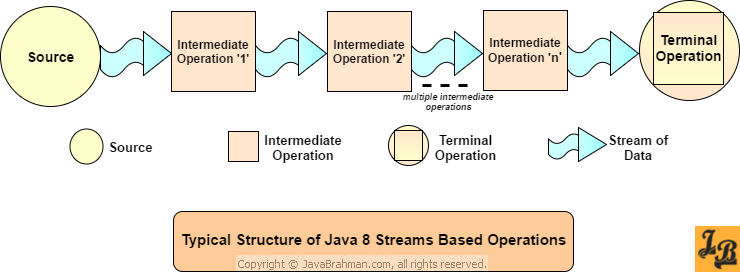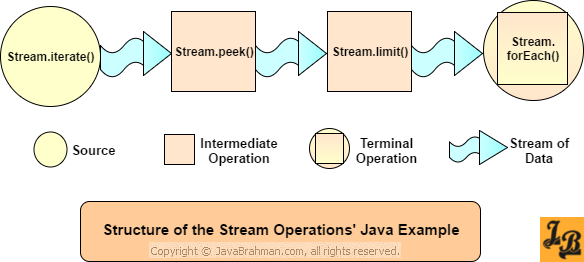Understanding Java 8 Streams Operations | Intermediate and Terminal Operations | Tutorial with examples
This tutorial explains the structure and basics of Stream operations, including the important concepts of intermediate and terminal operations in Java 8 Streams with examples. To begin with, it provides a high-level understanding of the structure of stream operations. Next, it explains how the lazy execution of Stream operations allows efficient and optimized execution of Streams. Lastly, it explains the two types of intermediate operations - stateful and stateless.
Structure of Java 8 Stream Operations
Any operation involving the use of Java 8 Streams API has to have three important components to make it work. These are - a source, one or more intermediate operations and a terminal operation. These three types of components are pipelinedClick to Read Tutorial explaining concept of Pipelines in Computing in a sequence to make a stream work.
Drawn as a diagram the pipelined operations for a stream would be arranged as shown below -
 Let us now understand the three components of stream operations shown above -
Let us now understand the three components of stream operations shown above -
Lazy execution of Streams and opportunity for optimizations
Lazy execution of Streams allow stream operations to be optimized by taking a high level view of the entire set of pipelined operations and then applying the optimization techniques to improve efficiency of execution.
Let us first take an example to understand the lazy nature of stream execution. Take a look at the following code, and its output, involving a Stream of even integers. The below code prints the first 5 even integers starting from the number 0 -
OUTPUT of the above code
And here is the same Stream Operations Structure diagram we saw above, this time changed to reflect the source, intermediate operations and terminal operation used in the code above -
 In the above code and diagram, Stream.iterate()Click to Read tutorial on Creating Infinite Streams using Stream.iterate() method generates an infinite number of even numbers starting from the initial value provided, i.e. 0. If Stream operations were not lazy and optimized, one would normally expected a large number of integers to be generated first using the
In the above code and diagram, Stream.iterate()Click to Read tutorial on Creating Infinite Streams using Stream.iterate() method generates an infinite number of even numbers starting from the initial value provided, i.e. 0. If Stream operations were not lazy and optimized, one would normally expected a large number of integers to be generated first using the
Instead, there are multiple optimizations at play here which make the above Stream efficient -
Conclusion
In this tutorial we understood the basics of Stream operations including their structure, intermediate and terminal operations, lazy nature of Stream operation execution and finally had a look at stateful and stateless Stream operations.
Drawn as a diagram the pipelined operations for a stream would be arranged as shown below -

- Source: Source is the source of data from which a stream is generated. It could be a collection on which
stream()method has been invoked, it could be an array, it could be a SupplierClick to read tutorial on Supplier Functional Interface instance generating infinite stream elements using the Stream.generate()Click to Read tutorial on Creating Infinite Streams with Stream.generate() method and so on. The source for your Stream's elements will depend on your business/technical requirement but the key thing to note is that you need a source for the stream to 'flow'. - Intermediate Operations: Intermediate operations of Streams have particular characteristic common to all of them. Intermediate Operations are invoked on a Stream instance and after they finish their processing they give a Stream instance as output. Examples of commonly used intermediate operations include Stream.map()Click to Read how Mapping with Java8 Streams works, Stream.filter()Click to Read how Filtering and Slicing with Java8 Streams works,
Stream.limit()and so on.
One way to look at the Stream operations would be to think of a Stream as an assembly line. There are the the raw materials(elements of stream) coming out from the source at one end. As the product(semi-processed data elements) being made moves forward, each intermediate workstation (or intermediate operation) keeps doing stuff on the product and keeps shaping the final product.
At a high-level, the concept of an assembly line works well for assimilating the concept of stream operations. However, internally within Streams logic there is an important difference. Stream elements are not processed continuously as one would assume. On the contrary, actual processing doesn't even start till a terminal operation(covered next) is invoked. Such a 'lazy' operation of Streams gives Java designers the ability to optimize and process Stream operation execution in a variety of ways. We will take a look at the lazy nature of Stream execution and couple of common optimizations in the next section. - Terminal Operations: Terminal operations are responsible for giving the 'final' output for a Stream in operation, and in the process they terminate a Stream. Terminal Operations thus do not return a Stream as their output. Apart from returning a Stream, terminal operations can return any value, or even no value(void) such as in the case of
forEach()method used above. Common examples of terminal values are findAny()Click to Read tutorial on findFirst() and findAny() methods of Streams API, allMatch()Click to Read tutorial on Matching with Streams API,forEach()etc.
Let us first take an example to understand the lazy nature of stream execution. Take a look at the following code, and its output, involving a Stream of even integers. The below code prints the first 5 even integers starting from the number 0 -
Code showing the lazy nature of Java 8 Stream operations
package com.javabrahman.java8.streams;
import java.util.stream.Stream;
public class InfiniteStreams {
public static void main(String args[]) {
Stream.iterate(0, n->n+2)
.peek(num -> System.out.println("Peeked at:"+num))
.limit(5)
.forEach(System.out::println);
}
}Peeked at: 0 0 Peeked at: 2 2 Peeked at: 4 4 Peeked at: 6 6 Peeked at: 8 8
And here is the same Stream Operations Structure diagram we saw above, this time changed to reflect the source, intermediate operations and terminal operation used in the code above -

Stream.iterate() method, which should have been 'peeked' at using Stream.peek()Click to Read tutorial on Stream.peek() method (another intermediate) operation. Finally, the Stream of elements would have been limited to just 5, and only first 5 of these huge list of numbers should have been printed using forEach() method.Instead, there are multiple optimizations at play here which make the above Stream efficient -
- Firstly, an important aspect to understand that the Stream execution, as I had mentioned earlier, is lazy. The actual execution of the Stream does not start till the terminal operation is encountered. So, one can have 'n' intermediate operations in a Stream pipeline, but the execution of these 'n' operations does not start unless the terminal operation (
forEach()in our case) is invoked. - Secondly, if you notice closely - only 5 even integers are generated, rather than a huge list. Lazy execution of Streams allows the implementing logic to 'understand' that there is a
limit(5)in the sequence of operations, and hence, finally only 5 elements will be used. So, the Stream never generates more than 5 elements. This optimization is technically named as Short-CircuitingClick to Read Tutorial explaining Short-Circuits in Computing! - Thirdly, each element is generated, peeked into, and printed as if these three operations were lined up as individual members of a single pass. In fact, we never specified the Stream operations in passes. The way we had defined the operations, first a large number of even integers(or 5 even integers if we consider short-circuiting) should have been generated which should have gotten printed in a bunch using the
peek()method. Only then these 5 integers should have been printed, again in a bunch, usingforEach(). Rather, what we see is that the three intermediate operations generate() - peek() - println using forEach() have been logically joined together to constitute a single pass, i.e. they are executed in order for each of the individual integers generated. This joining together of operations in a single pass is an optimization technique known as loop fusion.
- Stateful Intermediate Operations: Stateful intermediate operations are those which maintain information from a previous invocation internally(aka state) to be used again in a future invocation of the method. Intermediate operations such as Stream.distinct()Click to Read tutorial explaining filtering of distinct Stream elements, which needs to remember(or store) the previous elements it encountered, have to store state information from previous passes. This state storage can become huge for instances of infinite streams and hence can potentially affect performance of the whole system. Another example of stateful intermediate operation is Streams.sorted() which requires to store elements in a temporary storage as it sorts them over multiple passes.
- Stateless Intermediate Operations: Stateless intermediate operations are the opposite of stateful and do not store any state across passes. This not only improves the performance of these operations, which include among others
filter(),map(),findAny(), it also helps in executing the Stream operation invocations in parallel as there is no information to be shared, or any order to be maintained, between these invocations or passes.
Related Articles on Java 8 Streams API
Streams API - Introduction & BasicsClick to Read tutorial on Streams API Basics Mapping with Streams using map and flatMap methodsClick to Read how Mapping with Java8 Streams works Filtering and Slicing with Streams using filter,distinct,limit,skip methodsClick to Read how Filtering and Slicing with Java8 Streams works Matching with Streams using allMatch,anyMatch,noneMatch methodsClick to Read tutorial on matching with Streams API Stream API's findFirst,findAny methods' tutorialClick to Read tutorial on findFirst() and findAny() methods of Streams API 'Peeking' into a running Stream with Stream.peek() methodClick to Read tutorial on Stream.peek() method Creating Infinite Streams with iterate\generate methodsClick to Read tutorial on Creating Infinite Streams Reducing Streams using Streams.reduce methodClick to Read tutorial on Reducing Streams
Streams API - Introduction & BasicsClick to Read tutorial on Streams API Basics Mapping with Streams using map and flatMap methodsClick to Read how Mapping with Java8 Streams works Filtering and Slicing with Streams using filter,distinct,limit,skip methodsClick to Read how Filtering and Slicing with Java8 Streams works Matching with Streams using allMatch,anyMatch,noneMatch methodsClick to Read tutorial on matching with Streams API Stream API's findFirst,findAny methods' tutorialClick to Read tutorial on findFirst() and findAny() methods of Streams API 'Peeking' into a running Stream with Stream.peek() methodClick to Read tutorial on Stream.peek() method Creating Infinite Streams with iterate\generate methodsClick to Read tutorial on Creating Infinite Streams Reducing Streams using Streams.reduce methodClick to Read tutorial on Reducing Streams